SLEEP MEDICINE 11: SLEE5102 Sleep Disordered Breathing Assignment 1
VerifiedAdded on 2020/02/19
|22
|6414
|243
Homework Assignment
AI Summary
This sleep medicine assignment, SLEE5102, delves into the mechanics of breathing, encompassing inspiration and expiration, and the muscles involved, including the diaphragm, intercostals, and accessory muscles. It examines the impact of sleep on this process, highlighting how sleep alters airway resistance, affects chemoreceptor responses, and influences blood gas regulation. The assignment also explores the roles of central and peripheral chemoreceptors in maintaining normal blood gases, detailing their sensitivity to changes in CO2, O2, and pH levels and their feedback mechanisms to regulate ventilation. The central chemoreceptors, located on the ventrolateral medullary surface, are sensitive to CSF pH, while the peripheral chemoreceptors, found in the aortic and carotid bodies, monitor blood oxygen, carbon dioxide, and H+ ion concentrations. The assignment emphasizes the critical role of these chemoreceptors in maintaining homeostasis and responding to conditions like hypercapnia and hypoxia, thus ensuring proper respiratory function.
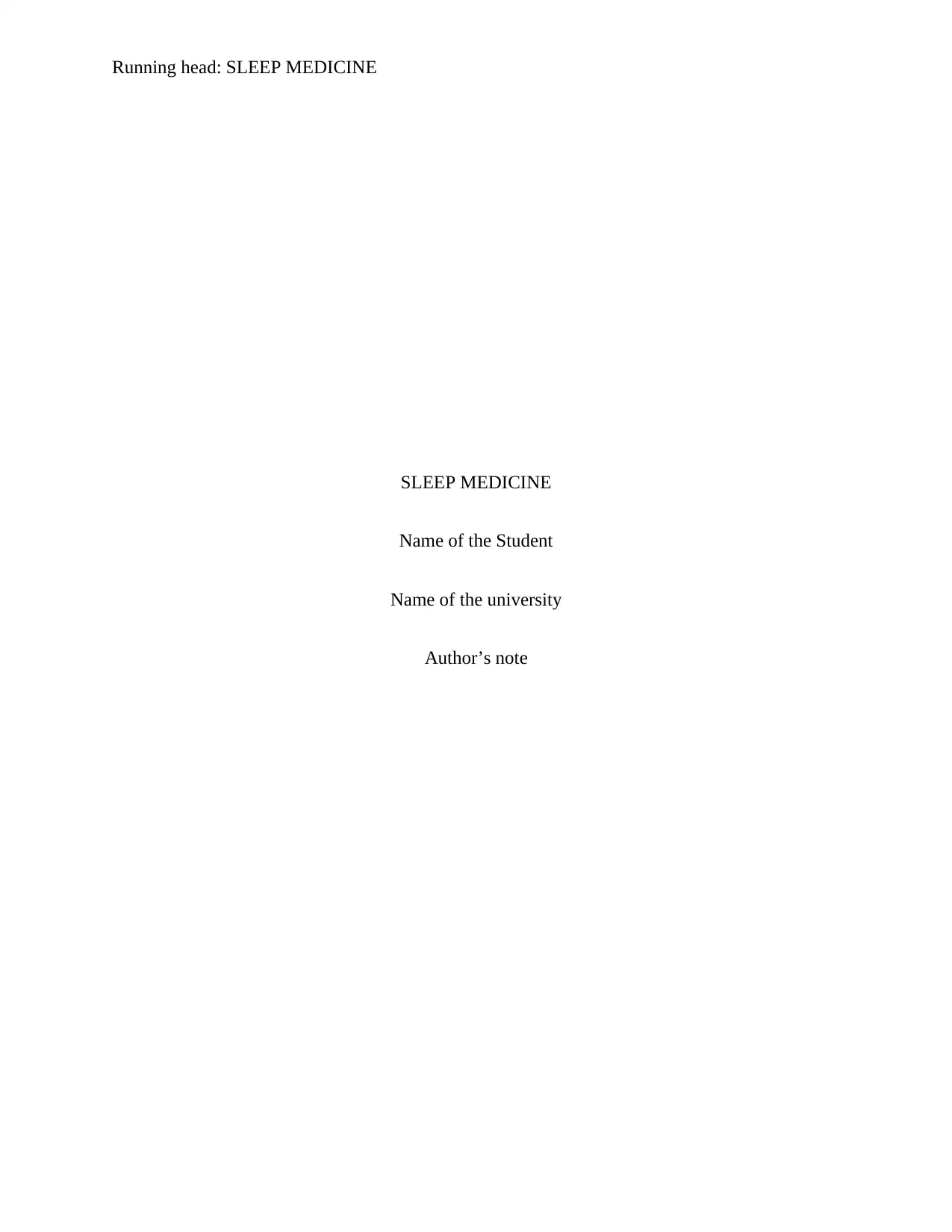
Running head: SLEEP MEDICINE
SLEEP MEDICINE
Name of the Student
Name of the university
Author’s note
SLEEP MEDICINE
Name of the Student
Name of the university
Author’s note
Paraphrase This Document
Need a fresh take? Get an instant paraphrase of this document with our AI Paraphraser
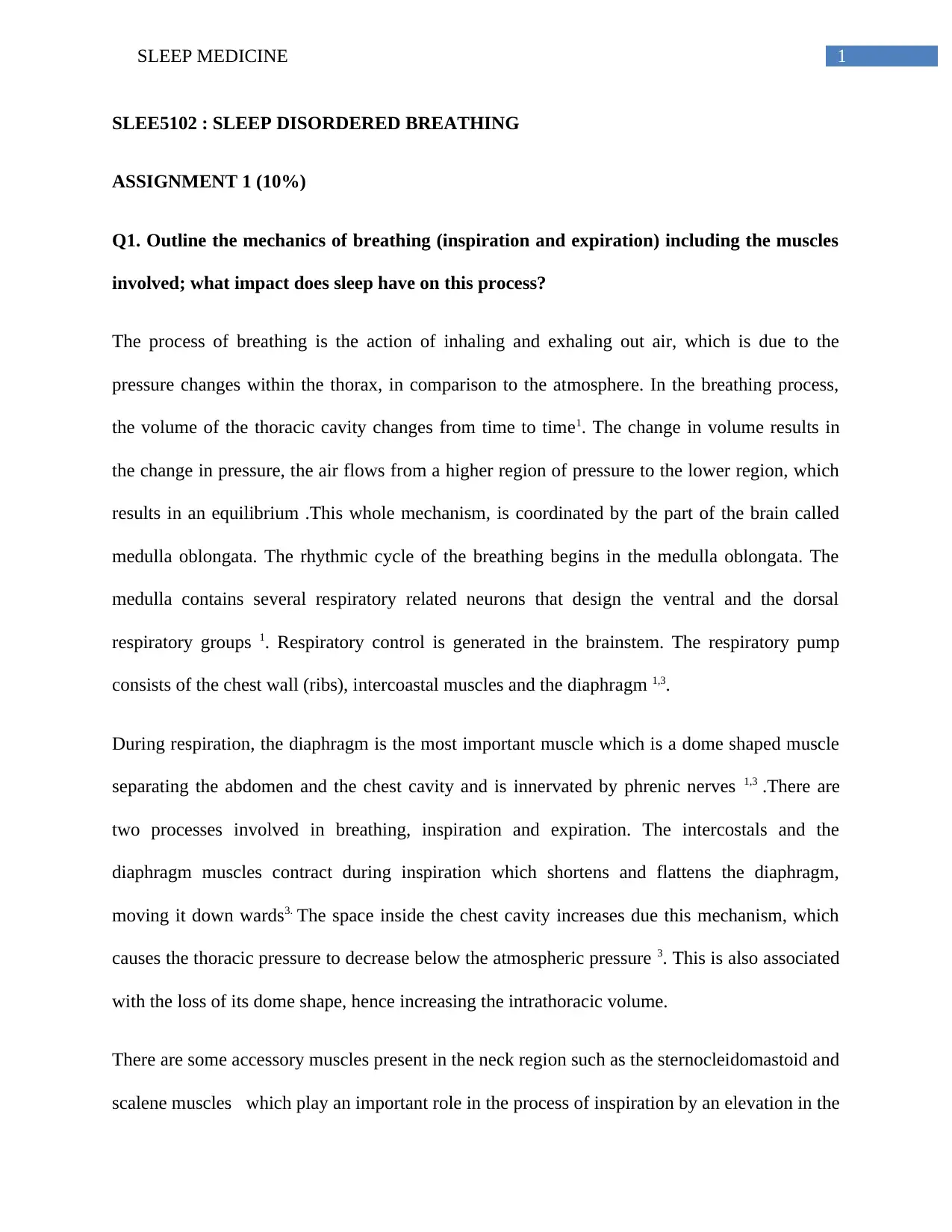
1SLEEP MEDICINE
SLEE5102 : SLEEP DISORDERED BREATHING
ASSIGNMENT 1 (10%)
Q1. Outline the mechanics of breathing (inspiration and expiration) including the muscles
involved; what impact does sleep have on this process?
The process of breathing is the action of inhaling and exhaling out air, which is due to the
pressure changes within the thorax, in comparison to the atmosphere. In the breathing process,
the volume of the thoracic cavity changes from time to time1. The change in volume results in
the change in pressure, the air flows from a higher region of pressure to the lower region, which
results in an equilibrium .This whole mechanism, is coordinated by the part of the brain called
medulla oblongata. The rhythmic cycle of the breathing begins in the medulla oblongata. The
medulla contains several respiratory related neurons that design the ventral and the dorsal
respiratory groups 1. Respiratory control is generated in the brainstem. The respiratory pump
consists of the chest wall (ribs), intercoastal muscles and the diaphragm 1,3.
During respiration, the diaphragm is the most important muscle which is a dome shaped muscle
separating the abdomen and the chest cavity and is innervated by phrenic nerves 1,3 .There are
two processes involved in breathing, inspiration and expiration. The intercostals and the
diaphragm muscles contract during inspiration which shortens and flattens the diaphragm,
moving it down wards3. The space inside the chest cavity increases due this mechanism, which
causes the thoracic pressure to decrease below the atmospheric pressure 3. This is also associated
with the loss of its dome shape, hence increasing the intrathoracic volume.
There are some accessory muscles present in the neck region such as the sternocleidomastoid and
scalene muscles which play an important role in the process of inspiration by an elevation in the
SLEE5102 : SLEEP DISORDERED BREATHING
ASSIGNMENT 1 (10%)
Q1. Outline the mechanics of breathing (inspiration and expiration) including the muscles
involved; what impact does sleep have on this process?
The process of breathing is the action of inhaling and exhaling out air, which is due to the
pressure changes within the thorax, in comparison to the atmosphere. In the breathing process,
the volume of the thoracic cavity changes from time to time1. The change in volume results in
the change in pressure, the air flows from a higher region of pressure to the lower region, which
results in an equilibrium .This whole mechanism, is coordinated by the part of the brain called
medulla oblongata. The rhythmic cycle of the breathing begins in the medulla oblongata. The
medulla contains several respiratory related neurons that design the ventral and the dorsal
respiratory groups 1. Respiratory control is generated in the brainstem. The respiratory pump
consists of the chest wall (ribs), intercoastal muscles and the diaphragm 1,3.
During respiration, the diaphragm is the most important muscle which is a dome shaped muscle
separating the abdomen and the chest cavity and is innervated by phrenic nerves 1,3 .There are
two processes involved in breathing, inspiration and expiration. The intercostals and the
diaphragm muscles contract during inspiration which shortens and flattens the diaphragm,
moving it down wards3. The space inside the chest cavity increases due this mechanism, which
causes the thoracic pressure to decrease below the atmospheric pressure 3. This is also associated
with the loss of its dome shape, hence increasing the intrathoracic volume.
There are some accessory muscles present in the neck region such as the sternocleidomastoid and
scalene muscles which play an important role in the process of inspiration by an elevation in the
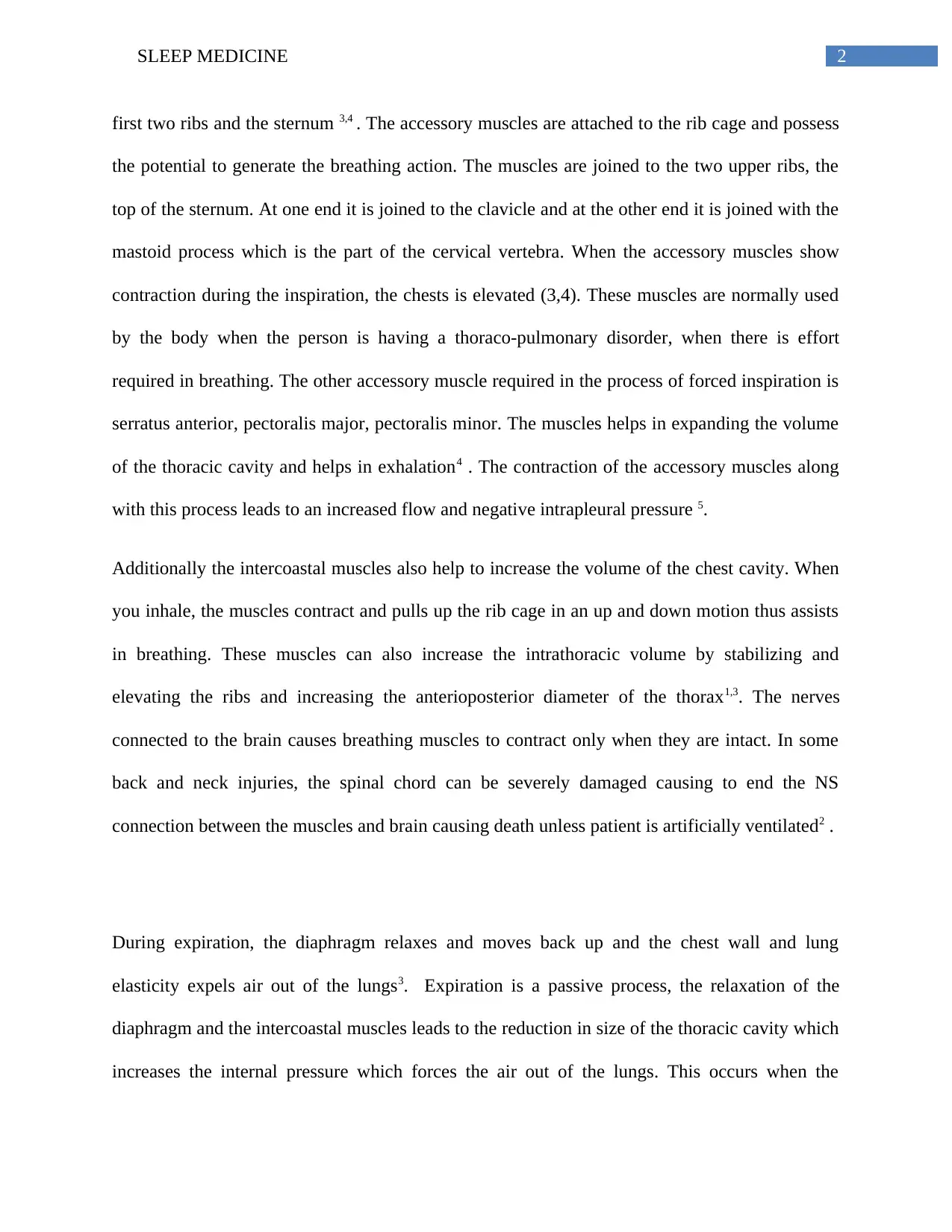
2SLEEP MEDICINE
first two ribs and the sternum 3,4 . The accessory muscles are attached to the rib cage and possess
the potential to generate the breathing action. The muscles are joined to the two upper ribs, the
top of the sternum. At one end it is joined to the clavicle and at the other end it is joined with the
mastoid process which is the part of the cervical vertebra. When the accessory muscles show
contraction during the inspiration, the chests is elevated (3,4). These muscles are normally used
by the body when the person is having a thoraco-pulmonary disorder, when there is effort
required in breathing. The other accessory muscle required in the process of forced inspiration is
serratus anterior, pectoralis major, pectoralis minor. The muscles helps in expanding the volume
of the thoracic cavity and helps in exhalation4 . The contraction of the accessory muscles along
with this process leads to an increased flow and negative intrapleural pressure 5.
Additionally the intercoastal muscles also help to increase the volume of the chest cavity. When
you inhale, the muscles contract and pulls up the rib cage in an up and down motion thus assists
in breathing. These muscles can also increase the intrathoracic volume by stabilizing and
elevating the ribs and increasing the anterioposterior diameter of the thorax1,3. The nerves
connected to the brain causes breathing muscles to contract only when they are intact. In some
back and neck injuries, the spinal chord can be severely damaged causing to end the NS
connection between the muscles and brain causing death unless patient is artificially ventilated2 .
During expiration, the diaphragm relaxes and moves back up and the chest wall and lung
elasticity expels air out of the lungs3. Expiration is a passive process, the relaxation of the
diaphragm and the intercoastal muscles leads to the reduction in size of the thoracic cavity which
increases the internal pressure which forces the air out of the lungs. This occurs when the
first two ribs and the sternum 3,4 . The accessory muscles are attached to the rib cage and possess
the potential to generate the breathing action. The muscles are joined to the two upper ribs, the
top of the sternum. At one end it is joined to the clavicle and at the other end it is joined with the
mastoid process which is the part of the cervical vertebra. When the accessory muscles show
contraction during the inspiration, the chests is elevated (3,4). These muscles are normally used
by the body when the person is having a thoraco-pulmonary disorder, when there is effort
required in breathing. The other accessory muscle required in the process of forced inspiration is
serratus anterior, pectoralis major, pectoralis minor. The muscles helps in expanding the volume
of the thoracic cavity and helps in exhalation4 . The contraction of the accessory muscles along
with this process leads to an increased flow and negative intrapleural pressure 5.
Additionally the intercoastal muscles also help to increase the volume of the chest cavity. When
you inhale, the muscles contract and pulls up the rib cage in an up and down motion thus assists
in breathing. These muscles can also increase the intrathoracic volume by stabilizing and
elevating the ribs and increasing the anterioposterior diameter of the thorax1,3. The nerves
connected to the brain causes breathing muscles to contract only when they are intact. In some
back and neck injuries, the spinal chord can be severely damaged causing to end the NS
connection between the muscles and brain causing death unless patient is artificially ventilated2 .
During expiration, the diaphragm relaxes and moves back up and the chest wall and lung
elasticity expels air out of the lungs3. Expiration is a passive process, the relaxation of the
diaphragm and the intercoastal muscles leads to the reduction in size of the thoracic cavity which
increases the internal pressure which forces the air out of the lungs. This occurs when the
⊘ This is a preview!⊘
Do you want full access?
Subscribe today to unlock all pages.

Trusted by 1+ million students worldwide
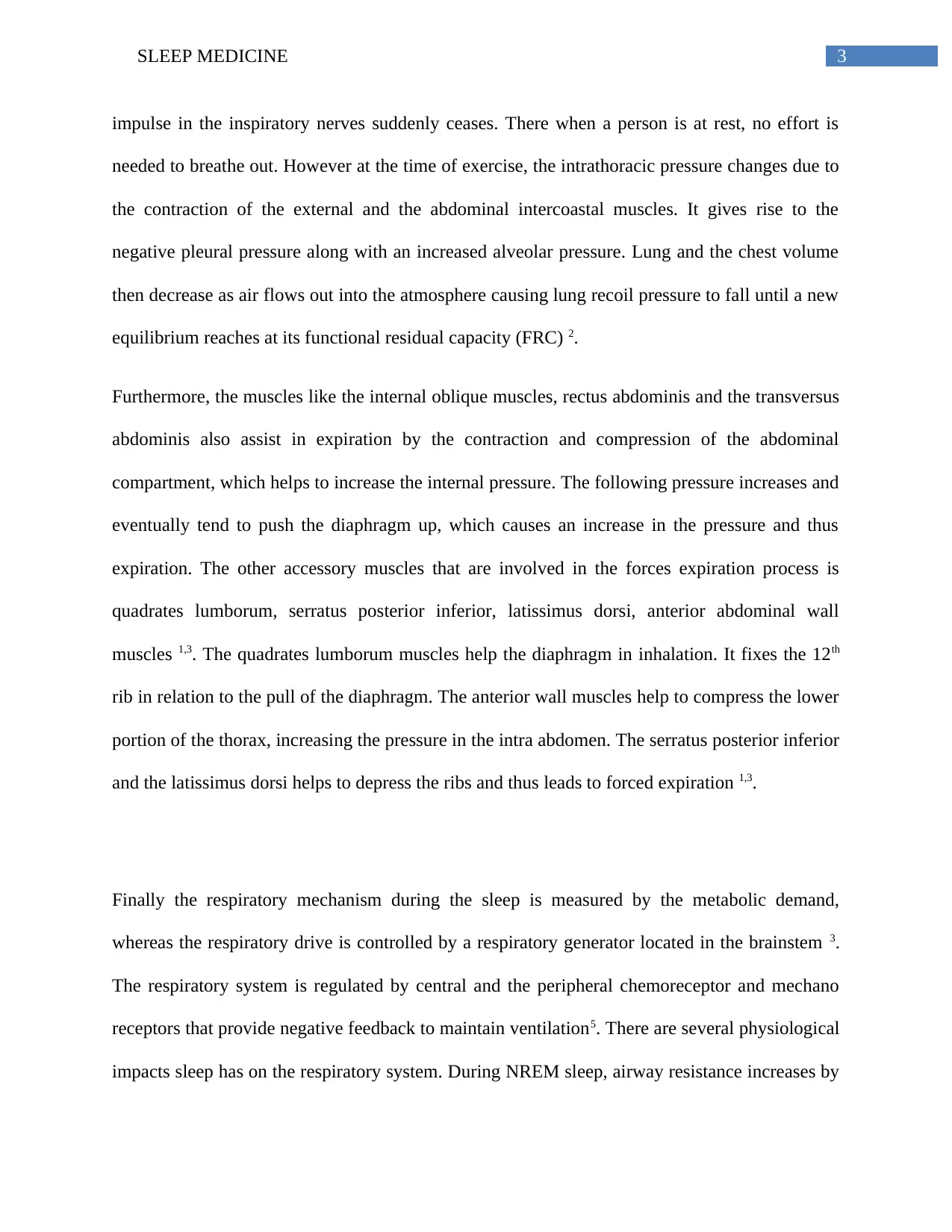
3SLEEP MEDICINE
impulse in the inspiratory nerves suddenly ceases. There when a person is at rest, no effort is
needed to breathe out. However at the time of exercise, the intrathoracic pressure changes due to
the contraction of the external and the abdominal intercoastal muscles. It gives rise to the
negative pleural pressure along with an increased alveolar pressure. Lung and the chest volume
then decrease as air flows out into the atmosphere causing lung recoil pressure to fall until a new
equilibrium reaches at its functional residual capacity (FRC) 2.
Furthermore, the muscles like the internal oblique muscles, rectus abdominis and the transversus
abdominis also assist in expiration by the contraction and compression of the abdominal
compartment, which helps to increase the internal pressure. The following pressure increases and
eventually tend to push the diaphragm up, which causes an increase in the pressure and thus
expiration. The other accessory muscles that are involved in the forces expiration process is
quadrates lumborum, serratus posterior inferior, latissimus dorsi, anterior abdominal wall
muscles 1,3. The quadrates lumborum muscles help the diaphragm in inhalation. It fixes the 12th
rib in relation to the pull of the diaphragm. The anterior wall muscles help to compress the lower
portion of the thorax, increasing the pressure in the intra abdomen. The serratus posterior inferior
and the latissimus dorsi helps to depress the ribs and thus leads to forced expiration 1,3.
Finally the respiratory mechanism during the sleep is measured by the metabolic demand,
whereas the respiratory drive is controlled by a respiratory generator located in the brainstem 3.
The respiratory system is regulated by central and the peripheral chemoreceptor and mechano
receptors that provide negative feedback to maintain ventilation5. There are several physiological
impacts sleep has on the respiratory system. During NREM sleep, airway resistance increases by
impulse in the inspiratory nerves suddenly ceases. There when a person is at rest, no effort is
needed to breathe out. However at the time of exercise, the intrathoracic pressure changes due to
the contraction of the external and the abdominal intercoastal muscles. It gives rise to the
negative pleural pressure along with an increased alveolar pressure. Lung and the chest volume
then decrease as air flows out into the atmosphere causing lung recoil pressure to fall until a new
equilibrium reaches at its functional residual capacity (FRC) 2.
Furthermore, the muscles like the internal oblique muscles, rectus abdominis and the transversus
abdominis also assist in expiration by the contraction and compression of the abdominal
compartment, which helps to increase the internal pressure. The following pressure increases and
eventually tend to push the diaphragm up, which causes an increase in the pressure and thus
expiration. The other accessory muscles that are involved in the forces expiration process is
quadrates lumborum, serratus posterior inferior, latissimus dorsi, anterior abdominal wall
muscles 1,3. The quadrates lumborum muscles help the diaphragm in inhalation. It fixes the 12th
rib in relation to the pull of the diaphragm. The anterior wall muscles help to compress the lower
portion of the thorax, increasing the pressure in the intra abdomen. The serratus posterior inferior
and the latissimus dorsi helps to depress the ribs and thus leads to forced expiration 1,3.
Finally the respiratory mechanism during the sleep is measured by the metabolic demand,
whereas the respiratory drive is controlled by a respiratory generator located in the brainstem 3.
The respiratory system is regulated by central and the peripheral chemoreceptor and mechano
receptors that provide negative feedback to maintain ventilation5. There are several physiological
impacts sleep has on the respiratory system. During NREM sleep, airway resistance increases by
Paraphrase This Document
Need a fresh take? Get an instant paraphrase of this document with our AI Paraphraser
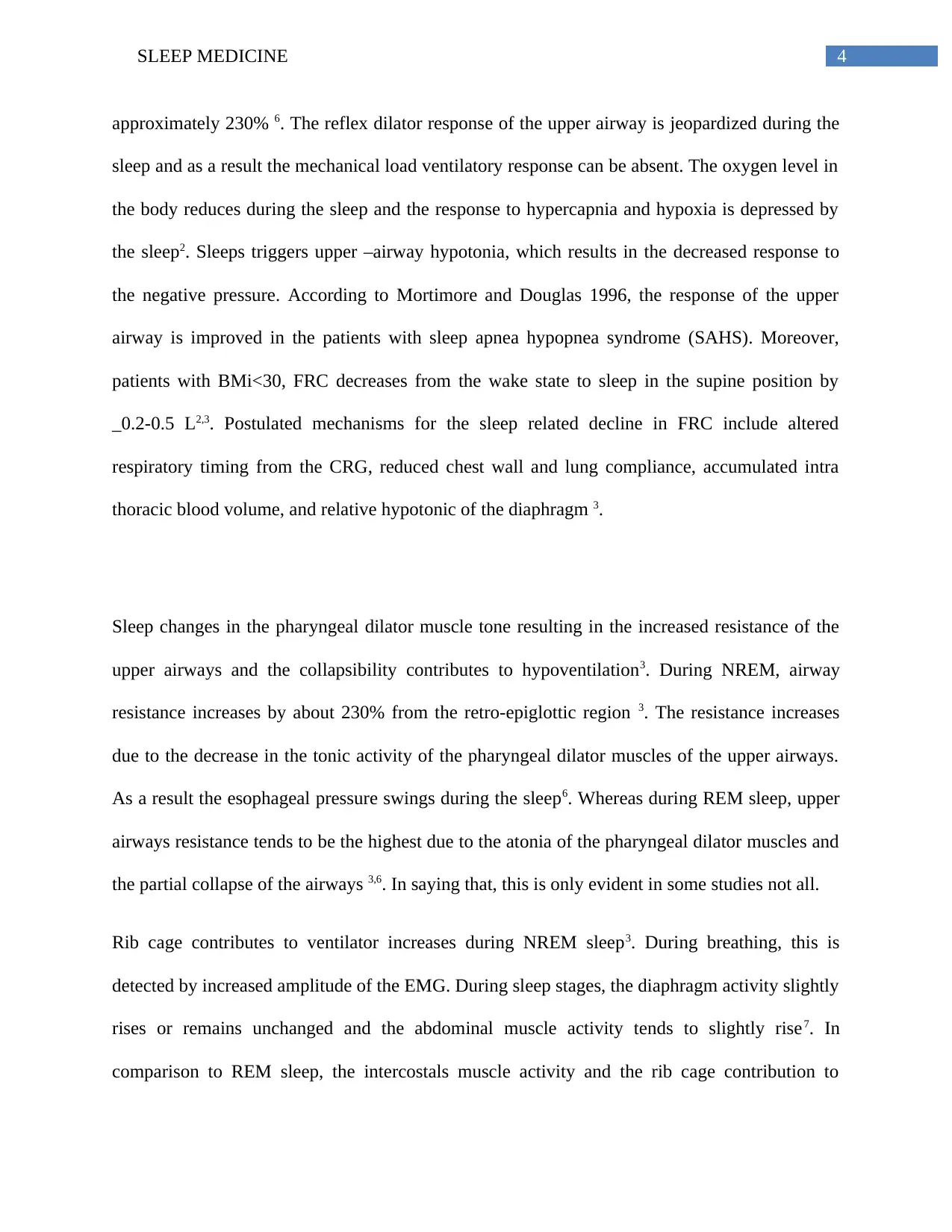
4SLEEP MEDICINE
approximately 230% 6. The reflex dilator response of the upper airway is jeopardized during the
sleep and as a result the mechanical load ventilatory response can be absent. The oxygen level in
the body reduces during the sleep and the response to hypercapnia and hypoxia is depressed by
the sleep2. Sleeps triggers upper –airway hypotonia, which results in the decreased response to
the negative pressure. According to Mortimore and Douglas 1996, the response of the upper
airway is improved in the patients with sleep apnea hypopnea syndrome (SAHS). Moreover,
patients with BMi<30, FRC decreases from the wake state to sleep in the supine position by
_0.2-0.5 L2,3. Postulated mechanisms for the sleep related decline in FRC include altered
respiratory timing from the CRG, reduced chest wall and lung compliance, accumulated intra
thoracic blood volume, and relative hypotonic of the diaphragm 3.
Sleep changes in the pharyngeal dilator muscle tone resulting in the increased resistance of the
upper airways and the collapsibility contributes to hypoventilation3. During NREM, airway
resistance increases by about 230% from the retro-epiglottic region 3. The resistance increases
due to the decrease in the tonic activity of the pharyngeal dilator muscles of the upper airways.
As a result the esophageal pressure swings during the sleep6. Whereas during REM sleep, upper
airways resistance tends to be the highest due to the atonia of the pharyngeal dilator muscles and
the partial collapse of the airways 3,6. In saying that, this is only evident in some studies not all.
Rib cage contributes to ventilator increases during NREM sleep3. During breathing, this is
detected by increased amplitude of the EMG. During sleep stages, the diaphragm activity slightly
rises or remains unchanged and the abdominal muscle activity tends to slightly rise7. In
comparison to REM sleep, the intercostals muscle activity and the rib cage contribution to
approximately 230% 6. The reflex dilator response of the upper airway is jeopardized during the
sleep and as a result the mechanical load ventilatory response can be absent. The oxygen level in
the body reduces during the sleep and the response to hypercapnia and hypoxia is depressed by
the sleep2. Sleeps triggers upper –airway hypotonia, which results in the decreased response to
the negative pressure. According to Mortimore and Douglas 1996, the response of the upper
airway is improved in the patients with sleep apnea hypopnea syndrome (SAHS). Moreover,
patients with BMi<30, FRC decreases from the wake state to sleep in the supine position by
_0.2-0.5 L2,3. Postulated mechanisms for the sleep related decline in FRC include altered
respiratory timing from the CRG, reduced chest wall and lung compliance, accumulated intra
thoracic blood volume, and relative hypotonic of the diaphragm 3.
Sleep changes in the pharyngeal dilator muscle tone resulting in the increased resistance of the
upper airways and the collapsibility contributes to hypoventilation3. During NREM, airway
resistance increases by about 230% from the retro-epiglottic region 3. The resistance increases
due to the decrease in the tonic activity of the pharyngeal dilator muscles of the upper airways.
As a result the esophageal pressure swings during the sleep6. Whereas during REM sleep, upper
airways resistance tends to be the highest due to the atonia of the pharyngeal dilator muscles and
the partial collapse of the airways 3,6. In saying that, this is only evident in some studies not all.
Rib cage contributes to ventilator increases during NREM sleep3. During breathing, this is
detected by increased amplitude of the EMG. During sleep stages, the diaphragm activity slightly
rises or remains unchanged and the abdominal muscle activity tends to slightly rise7. In
comparison to REM sleep, the intercostals muscle activity and the rib cage contribution to
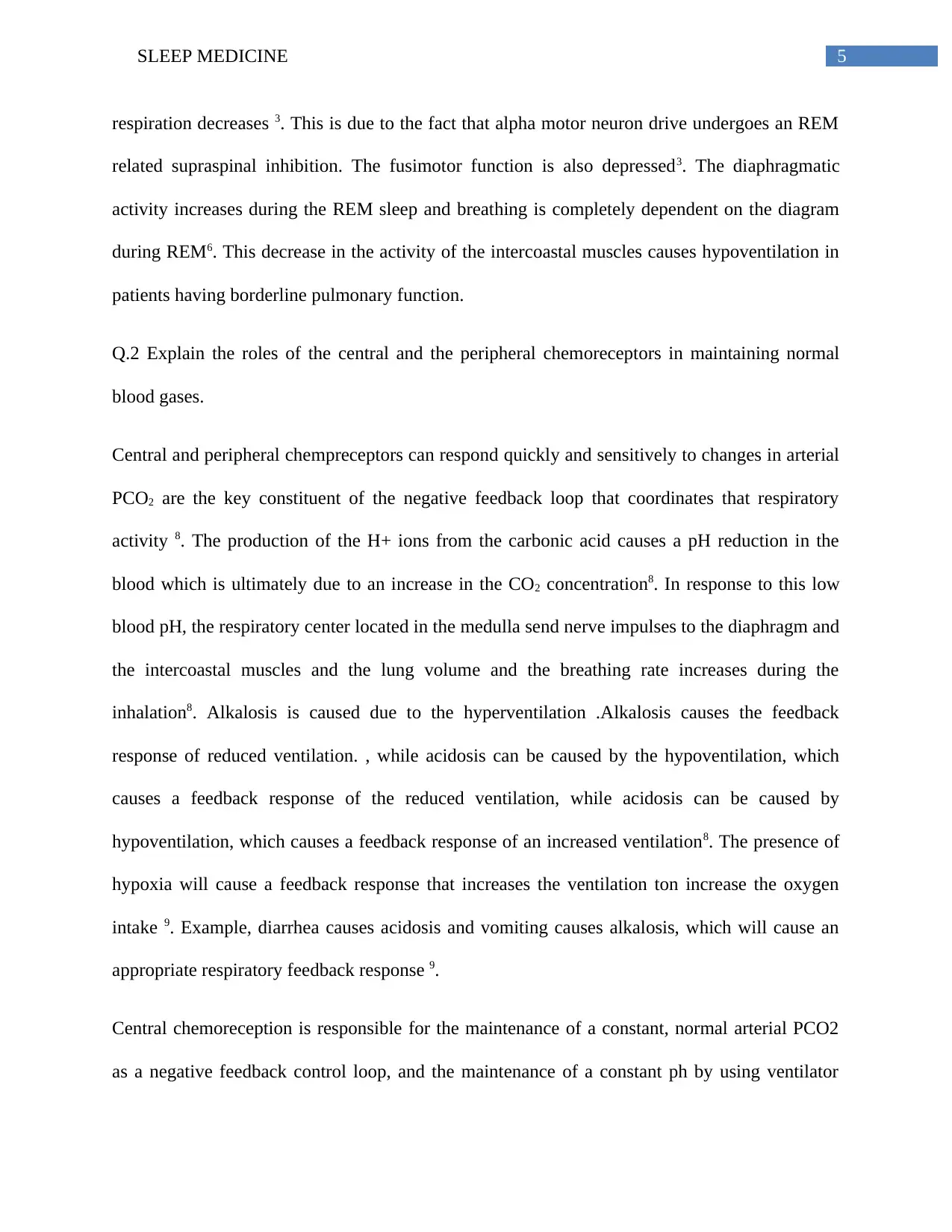
5SLEEP MEDICINE
respiration decreases 3. This is due to the fact that alpha motor neuron drive undergoes an REM
related supraspinal inhibition. The fusimotor function is also depressed3. The diaphragmatic
activity increases during the REM sleep and breathing is completely dependent on the diagram
during REM6. This decrease in the activity of the intercoastal muscles causes hypoventilation in
patients having borderline pulmonary function.
Q.2 Explain the roles of the central and the peripheral chemoreceptors in maintaining normal
blood gases.
Central and peripheral chempreceptors can respond quickly and sensitively to changes in arterial
PCO2 are the key constituent of the negative feedback loop that coordinates that respiratory
activity 8. The production of the H+ ions from the carbonic acid causes a pH reduction in the
blood which is ultimately due to an increase in the CO2 concentration8. In response to this low
blood pH, the respiratory center located in the medulla send nerve impulses to the diaphragm and
the intercoastal muscles and the lung volume and the breathing rate increases during the
inhalation8. Alkalosis is caused due to the hyperventilation .Alkalosis causes the feedback
response of reduced ventilation. , while acidosis can be caused by the hypoventilation, which
causes a feedback response of the reduced ventilation, while acidosis can be caused by
hypoventilation, which causes a feedback response of an increased ventilation8. The presence of
hypoxia will cause a feedback response that increases the ventilation ton increase the oxygen
intake 9. Example, diarrhea causes acidosis and vomiting causes alkalosis, which will cause an
appropriate respiratory feedback response 9.
Central chemoreception is responsible for the maintenance of a constant, normal arterial PCO2
as a negative feedback control loop, and the maintenance of a constant ph by using ventilator
respiration decreases 3. This is due to the fact that alpha motor neuron drive undergoes an REM
related supraspinal inhibition. The fusimotor function is also depressed3. The diaphragmatic
activity increases during the REM sleep and breathing is completely dependent on the diagram
during REM6. This decrease in the activity of the intercoastal muscles causes hypoventilation in
patients having borderline pulmonary function.
Q.2 Explain the roles of the central and the peripheral chemoreceptors in maintaining normal
blood gases.
Central and peripheral chempreceptors can respond quickly and sensitively to changes in arterial
PCO2 are the key constituent of the negative feedback loop that coordinates that respiratory
activity 8. The production of the H+ ions from the carbonic acid causes a pH reduction in the
blood which is ultimately due to an increase in the CO2 concentration8. In response to this low
blood pH, the respiratory center located in the medulla send nerve impulses to the diaphragm and
the intercoastal muscles and the lung volume and the breathing rate increases during the
inhalation8. Alkalosis is caused due to the hyperventilation .Alkalosis causes the feedback
response of reduced ventilation. , while acidosis can be caused by the hypoventilation, which
causes a feedback response of the reduced ventilation, while acidosis can be caused by
hypoventilation, which causes a feedback response of an increased ventilation8. The presence of
hypoxia will cause a feedback response that increases the ventilation ton increase the oxygen
intake 9. Example, diarrhea causes acidosis and vomiting causes alkalosis, which will cause an
appropriate respiratory feedback response 9.
Central chemoreception is responsible for the maintenance of a constant, normal arterial PCO2
as a negative feedback control loop, and the maintenance of a constant ph by using ventilator
⊘ This is a preview!⊘
Do you want full access?
Subscribe today to unlock all pages.

Trusted by 1+ million students worldwide
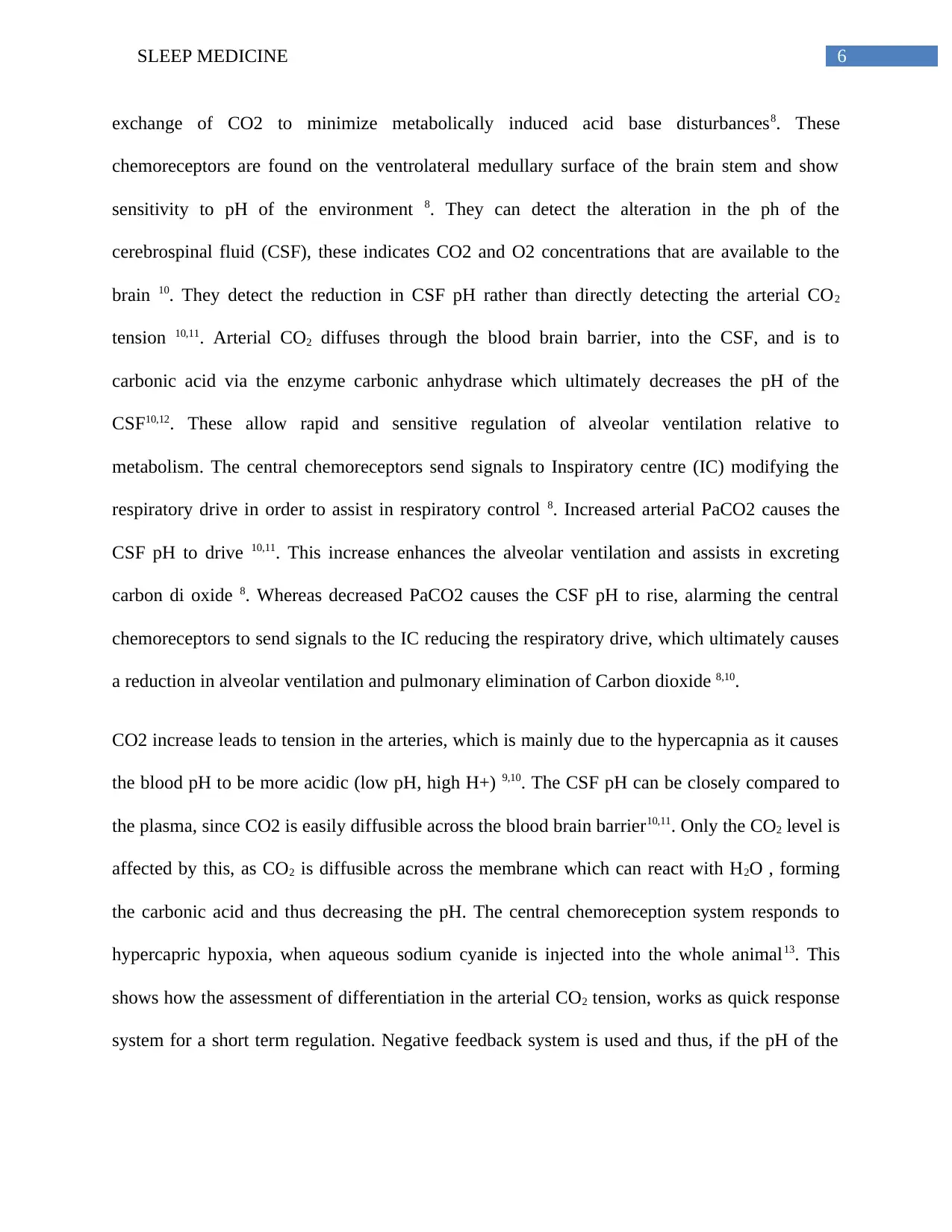
6SLEEP MEDICINE
exchange of CO2 to minimize metabolically induced acid base disturbances8. These
chemoreceptors are found on the ventrolateral medullary surface of the brain stem and show
sensitivity to pH of the environment 8. They can detect the alteration in the ph of the
cerebrospinal fluid (CSF), these indicates CO2 and O2 concentrations that are available to the
brain 10. They detect the reduction in CSF pH rather than directly detecting the arterial CO2
tension 10,11. Arterial CO2 diffuses through the blood brain barrier, into the CSF, and is to
carbonic acid via the enzyme carbonic anhydrase which ultimately decreases the pH of the
CSF10,12. These allow rapid and sensitive regulation of alveolar ventilation relative to
metabolism. The central chemoreceptors send signals to Inspiratory centre (IC) modifying the
respiratory drive in order to assist in respiratory control 8. Increased arterial PaCO2 causes the
CSF pH to drive 10,11. This increase enhances the alveolar ventilation and assists in excreting
carbon di oxide 8. Whereas decreased PaCO2 causes the CSF pH to rise, alarming the central
chemoreceptors to send signals to the IC reducing the respiratory drive, which ultimately causes
a reduction in alveolar ventilation and pulmonary elimination of Carbon dioxide 8,10.
CO2 increase leads to tension in the arteries, which is mainly due to the hypercapnia as it causes
the blood pH to be more acidic (low pH, high H+) 9,10. The CSF pH can be closely compared to
the plasma, since CO2 is easily diffusible across the blood brain barrier10,11. Only the CO2 level is
affected by this, as CO2 is diffusible across the membrane which can react with H2O , forming
the carbonic acid and thus decreasing the pH. The central chemoreception system responds to
hypercapric hypoxia, when aqueous sodium cyanide is injected into the whole animal13. This
shows how the assessment of differentiation in the arterial CO2 tension, works as quick response
system for a short term regulation. Negative feedback system is used and thus, if the pH of the
exchange of CO2 to minimize metabolically induced acid base disturbances8. These
chemoreceptors are found on the ventrolateral medullary surface of the brain stem and show
sensitivity to pH of the environment 8. They can detect the alteration in the ph of the
cerebrospinal fluid (CSF), these indicates CO2 and O2 concentrations that are available to the
brain 10. They detect the reduction in CSF pH rather than directly detecting the arterial CO2
tension 10,11. Arterial CO2 diffuses through the blood brain barrier, into the CSF, and is to
carbonic acid via the enzyme carbonic anhydrase which ultimately decreases the pH of the
CSF10,12. These allow rapid and sensitive regulation of alveolar ventilation relative to
metabolism. The central chemoreceptors send signals to Inspiratory centre (IC) modifying the
respiratory drive in order to assist in respiratory control 8. Increased arterial PaCO2 causes the
CSF pH to drive 10,11. This increase enhances the alveolar ventilation and assists in excreting
carbon di oxide 8. Whereas decreased PaCO2 causes the CSF pH to rise, alarming the central
chemoreceptors to send signals to the IC reducing the respiratory drive, which ultimately causes
a reduction in alveolar ventilation and pulmonary elimination of Carbon dioxide 8,10.
CO2 increase leads to tension in the arteries, which is mainly due to the hypercapnia as it causes
the blood pH to be more acidic (low pH, high H+) 9,10. The CSF pH can be closely compared to
the plasma, since CO2 is easily diffusible across the blood brain barrier10,11. Only the CO2 level is
affected by this, as CO2 is diffusible across the membrane which can react with H2O , forming
the carbonic acid and thus decreasing the pH. The central chemoreception system responds to
hypercapric hypoxia, when aqueous sodium cyanide is injected into the whole animal13. This
shows how the assessment of differentiation in the arterial CO2 tension, works as quick response
system for a short term regulation. Negative feedback system is used and thus, if the pH of the
Paraphrase This Document
Need a fresh take? Get an instant paraphrase of this document with our AI Paraphraser
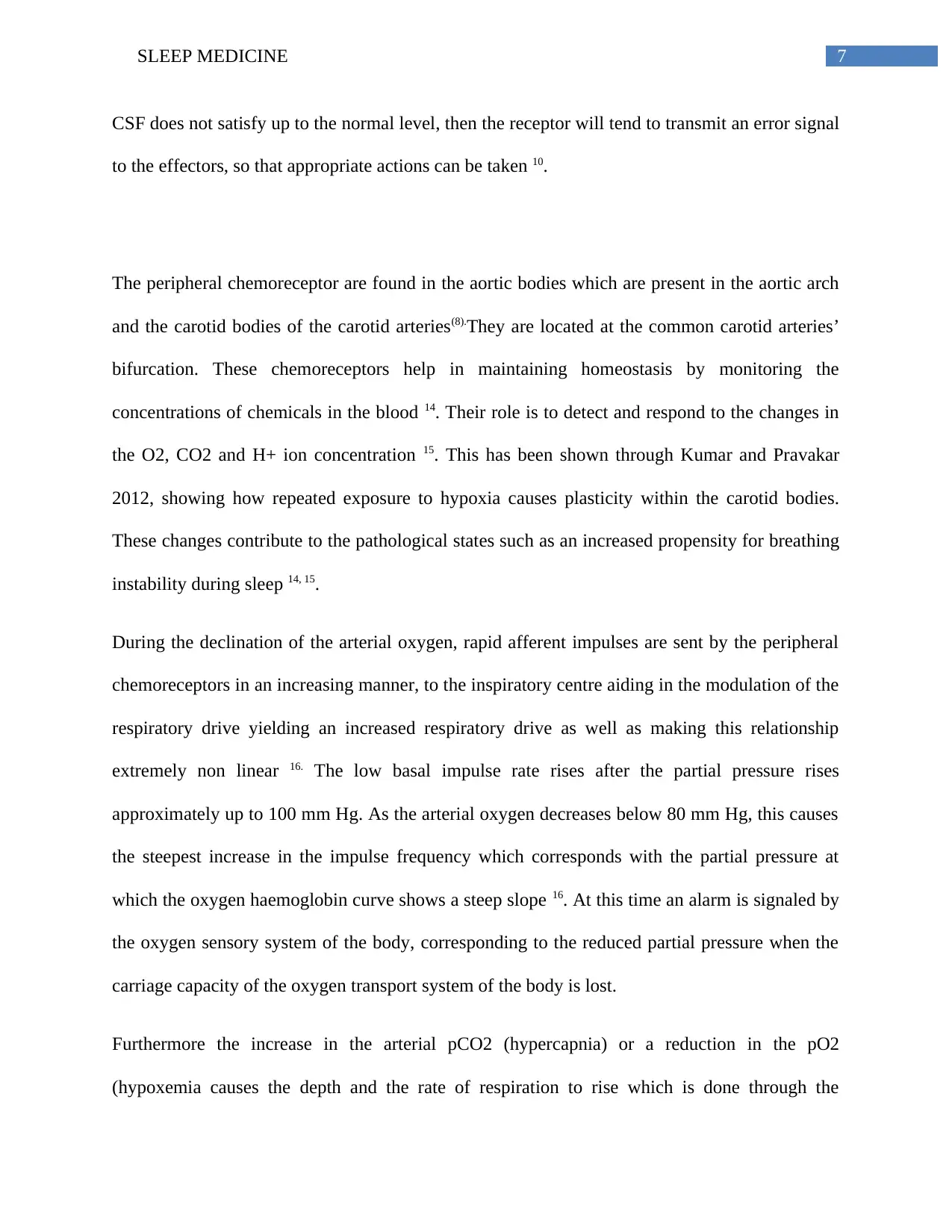
7SLEEP MEDICINE
CSF does not satisfy up to the normal level, then the receptor will tend to transmit an error signal
to the effectors, so that appropriate actions can be taken 10.
The peripheral chemoreceptor are found in the aortic bodies which are present in the aortic arch
and the carotid bodies of the carotid arteries(8).They are located at the common carotid arteries’
bifurcation. These chemoreceptors help in maintaining homeostasis by monitoring the
concentrations of chemicals in the blood 14. Their role is to detect and respond to the changes in
the O2, CO2 and H+ ion concentration 15. This has been shown through Kumar and Pravakar
2012, showing how repeated exposure to hypoxia causes plasticity within the carotid bodies.
These changes contribute to the pathological states such as an increased propensity for breathing
instability during sleep 14, 15.
During the declination of the arterial oxygen, rapid afferent impulses are sent by the peripheral
chemoreceptors in an increasing manner, to the inspiratory centre aiding in the modulation of the
respiratory drive yielding an increased respiratory drive as well as making this relationship
extremely non linear 16. The low basal impulse rate rises after the partial pressure rises
approximately up to 100 mm Hg. As the arterial oxygen decreases below 80 mm Hg, this causes
the steepest increase in the impulse frequency which corresponds with the partial pressure at
which the oxygen haemoglobin curve shows a steep slope 16. At this time an alarm is signaled by
the oxygen sensory system of the body, corresponding to the reduced partial pressure when the
carriage capacity of the oxygen transport system of the body is lost.
Furthermore the increase in the arterial pCO2 (hypercapnia) or a reduction in the pO2
(hypoxemia causes the depth and the rate of respiration to rise which is done through the
CSF does not satisfy up to the normal level, then the receptor will tend to transmit an error signal
to the effectors, so that appropriate actions can be taken 10.
The peripheral chemoreceptor are found in the aortic bodies which are present in the aortic arch
and the carotid bodies of the carotid arteries(8).They are located at the common carotid arteries’
bifurcation. These chemoreceptors help in maintaining homeostasis by monitoring the
concentrations of chemicals in the blood 14. Their role is to detect and respond to the changes in
the O2, CO2 and H+ ion concentration 15. This has been shown through Kumar and Pravakar
2012, showing how repeated exposure to hypoxia causes plasticity within the carotid bodies.
These changes contribute to the pathological states such as an increased propensity for breathing
instability during sleep 14, 15.
During the declination of the arterial oxygen, rapid afferent impulses are sent by the peripheral
chemoreceptors in an increasing manner, to the inspiratory centre aiding in the modulation of the
respiratory drive yielding an increased respiratory drive as well as making this relationship
extremely non linear 16. The low basal impulse rate rises after the partial pressure rises
approximately up to 100 mm Hg. As the arterial oxygen decreases below 80 mm Hg, this causes
the steepest increase in the impulse frequency which corresponds with the partial pressure at
which the oxygen haemoglobin curve shows a steep slope 16. At this time an alarm is signaled by
the oxygen sensory system of the body, corresponding to the reduced partial pressure when the
carriage capacity of the oxygen transport system of the body is lost.
Furthermore the increase in the arterial pCO2 (hypercapnia) or a reduction in the pO2
(hypoxemia causes the depth and the rate of respiration to rise which is done through the
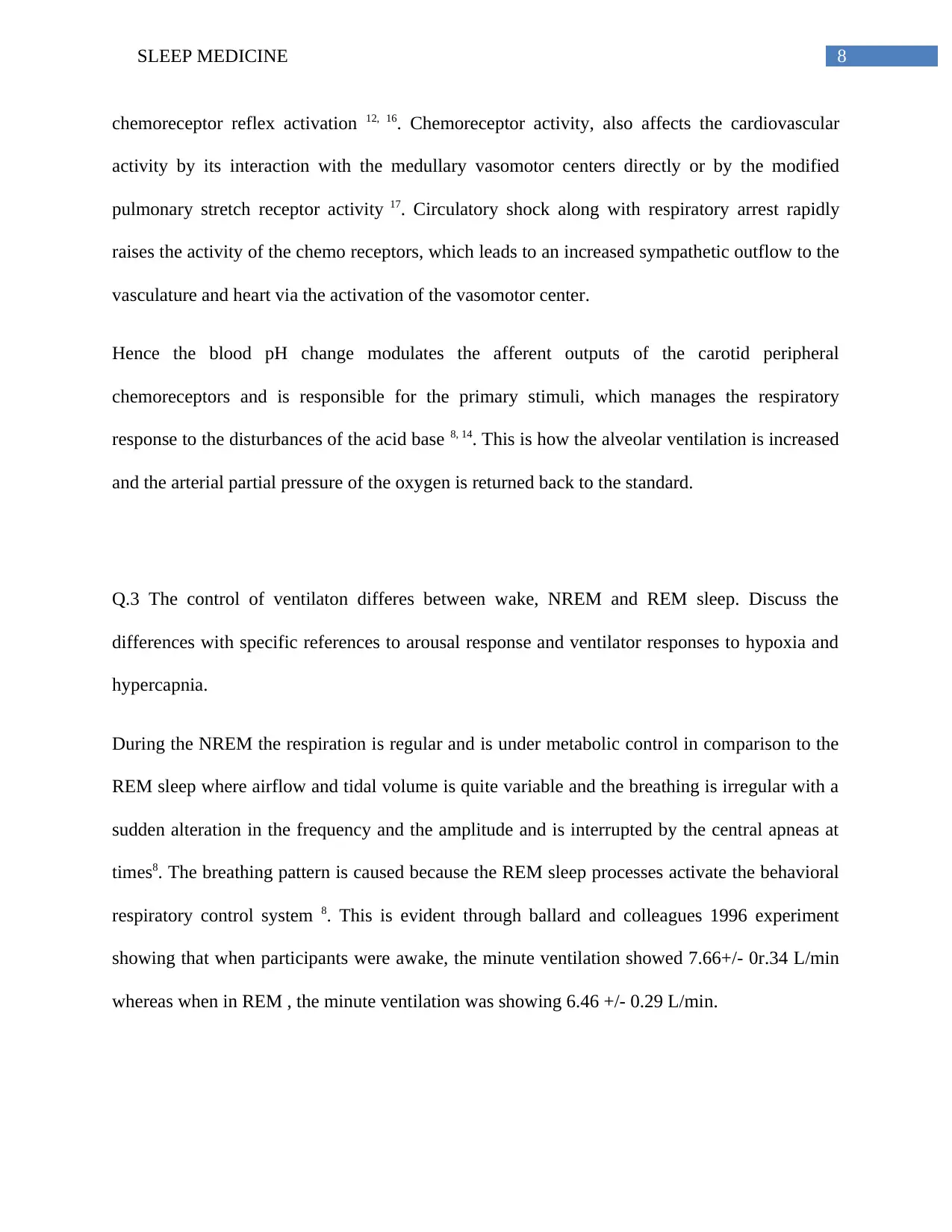
8SLEEP MEDICINE
chemoreceptor reflex activation 12, 16. Chemoreceptor activity, also affects the cardiovascular
activity by its interaction with the medullary vasomotor centers directly or by the modified
pulmonary stretch receptor activity 17. Circulatory shock along with respiratory arrest rapidly
raises the activity of the chemo receptors, which leads to an increased sympathetic outflow to the
vasculature and heart via the activation of the vasomotor center.
Hence the blood pH change modulates the afferent outputs of the carotid peripheral
chemoreceptors and is responsible for the primary stimuli, which manages the respiratory
response to the disturbances of the acid base 8, 14. This is how the alveolar ventilation is increased
and the arterial partial pressure of the oxygen is returned back to the standard.
Q.3 The control of ventilaton differes between wake, NREM and REM sleep. Discuss the
differences with specific references to arousal response and ventilator responses to hypoxia and
hypercapnia.
During the NREM the respiration is regular and is under metabolic control in comparison to the
REM sleep where airflow and tidal volume is quite variable and the breathing is irregular with a
sudden alteration in the frequency and the amplitude and is interrupted by the central apneas at
times8. The breathing pattern is caused because the REM sleep processes activate the behavioral
respiratory control system 8. This is evident through ballard and colleagues 1996 experiment
showing that when participants were awake, the minute ventilation showed 7.66+/- 0r.34 L/min
whereas when in REM , the minute ventilation was showing 6.46 +/- 0.29 L/min.
chemoreceptor reflex activation 12, 16. Chemoreceptor activity, also affects the cardiovascular
activity by its interaction with the medullary vasomotor centers directly or by the modified
pulmonary stretch receptor activity 17. Circulatory shock along with respiratory arrest rapidly
raises the activity of the chemo receptors, which leads to an increased sympathetic outflow to the
vasculature and heart via the activation of the vasomotor center.
Hence the blood pH change modulates the afferent outputs of the carotid peripheral
chemoreceptors and is responsible for the primary stimuli, which manages the respiratory
response to the disturbances of the acid base 8, 14. This is how the alveolar ventilation is increased
and the arterial partial pressure of the oxygen is returned back to the standard.
Q.3 The control of ventilaton differes between wake, NREM and REM sleep. Discuss the
differences with specific references to arousal response and ventilator responses to hypoxia and
hypercapnia.
During the NREM the respiration is regular and is under metabolic control in comparison to the
REM sleep where airflow and tidal volume is quite variable and the breathing is irregular with a
sudden alteration in the frequency and the amplitude and is interrupted by the central apneas at
times8. The breathing pattern is caused because the REM sleep processes activate the behavioral
respiratory control system 8. This is evident through ballard and colleagues 1996 experiment
showing that when participants were awake, the minute ventilation showed 7.66+/- 0r.34 L/min
whereas when in REM , the minute ventilation was showing 6.46 +/- 0.29 L/min.
⊘ This is a preview!⊘
Do you want full access?
Subscribe today to unlock all pages.

Trusted by 1+ million students worldwide
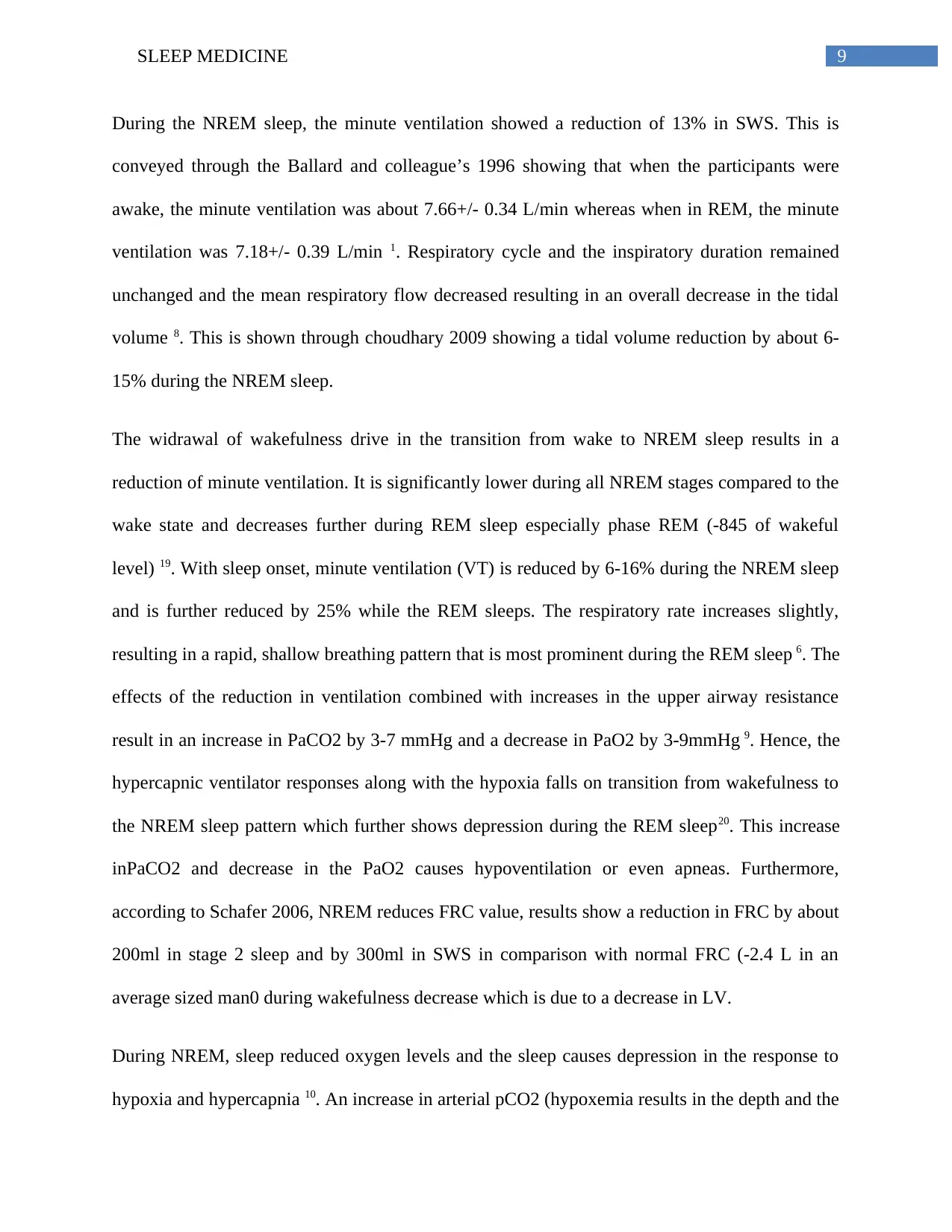
9SLEEP MEDICINE
During the NREM sleep, the minute ventilation showed a reduction of 13% in SWS. This is
conveyed through the Ballard and colleague’s 1996 showing that when the participants were
awake, the minute ventilation was about 7.66+/- 0.34 L/min whereas when in REM, the minute
ventilation was 7.18+/- 0.39 L/min 1. Respiratory cycle and the inspiratory duration remained
unchanged and the mean respiratory flow decreased resulting in an overall decrease in the tidal
volume 8. This is shown through choudhary 2009 showing a tidal volume reduction by about 6-
15% during the NREM sleep.
The widrawal of wakefulness drive in the transition from wake to NREM sleep results in a
reduction of minute ventilation. It is significantly lower during all NREM stages compared to the
wake state and decreases further during REM sleep especially phase REM (-845 of wakeful
level) 19. With sleep onset, minute ventilation (VT) is reduced by 6-16% during the NREM sleep
and is further reduced by 25% while the REM sleeps. The respiratory rate increases slightly,
resulting in a rapid, shallow breathing pattern that is most prominent during the REM sleep 6. The
effects of the reduction in ventilation combined with increases in the upper airway resistance
result in an increase in PaCO2 by 3-7 mmHg and a decrease in PaO2 by 3-9mmHg 9. Hence, the
hypercapnic ventilator responses along with the hypoxia falls on transition from wakefulness to
the NREM sleep pattern which further shows depression during the REM sleep20. This increase
inPaCO2 and decrease in the PaO2 causes hypoventilation or even apneas. Furthermore,
according to Schafer 2006, NREM reduces FRC value, results show a reduction in FRC by about
200ml in stage 2 sleep and by 300ml in SWS in comparison with normal FRC (-2.4 L in an
average sized man0 during wakefulness decrease which is due to a decrease in LV.
During NREM, sleep reduced oxygen levels and the sleep causes depression in the response to
hypoxia and hypercapnia 10. An increase in arterial pCO2 (hypoxemia results in the depth and the
During the NREM sleep, the minute ventilation showed a reduction of 13% in SWS. This is
conveyed through the Ballard and colleague’s 1996 showing that when the participants were
awake, the minute ventilation was about 7.66+/- 0.34 L/min whereas when in REM, the minute
ventilation was 7.18+/- 0.39 L/min 1. Respiratory cycle and the inspiratory duration remained
unchanged and the mean respiratory flow decreased resulting in an overall decrease in the tidal
volume 8. This is shown through choudhary 2009 showing a tidal volume reduction by about 6-
15% during the NREM sleep.
The widrawal of wakefulness drive in the transition from wake to NREM sleep results in a
reduction of minute ventilation. It is significantly lower during all NREM stages compared to the
wake state and decreases further during REM sleep especially phase REM (-845 of wakeful
level) 19. With sleep onset, minute ventilation (VT) is reduced by 6-16% during the NREM sleep
and is further reduced by 25% while the REM sleeps. The respiratory rate increases slightly,
resulting in a rapid, shallow breathing pattern that is most prominent during the REM sleep 6. The
effects of the reduction in ventilation combined with increases in the upper airway resistance
result in an increase in PaCO2 by 3-7 mmHg and a decrease in PaO2 by 3-9mmHg 9. Hence, the
hypercapnic ventilator responses along with the hypoxia falls on transition from wakefulness to
the NREM sleep pattern which further shows depression during the REM sleep20. This increase
inPaCO2 and decrease in the PaO2 causes hypoventilation or even apneas. Furthermore,
according to Schafer 2006, NREM reduces FRC value, results show a reduction in FRC by about
200ml in stage 2 sleep and by 300ml in SWS in comparison with normal FRC (-2.4 L in an
average sized man0 during wakefulness decrease which is due to a decrease in LV.
During NREM, sleep reduced oxygen levels and the sleep causes depression in the response to
hypoxia and hypercapnia 10. An increase in arterial pCO2 (hypoxemia results in the depth and the
Paraphrase This Document
Need a fresh take? Get an instant paraphrase of this document with our AI Paraphraser
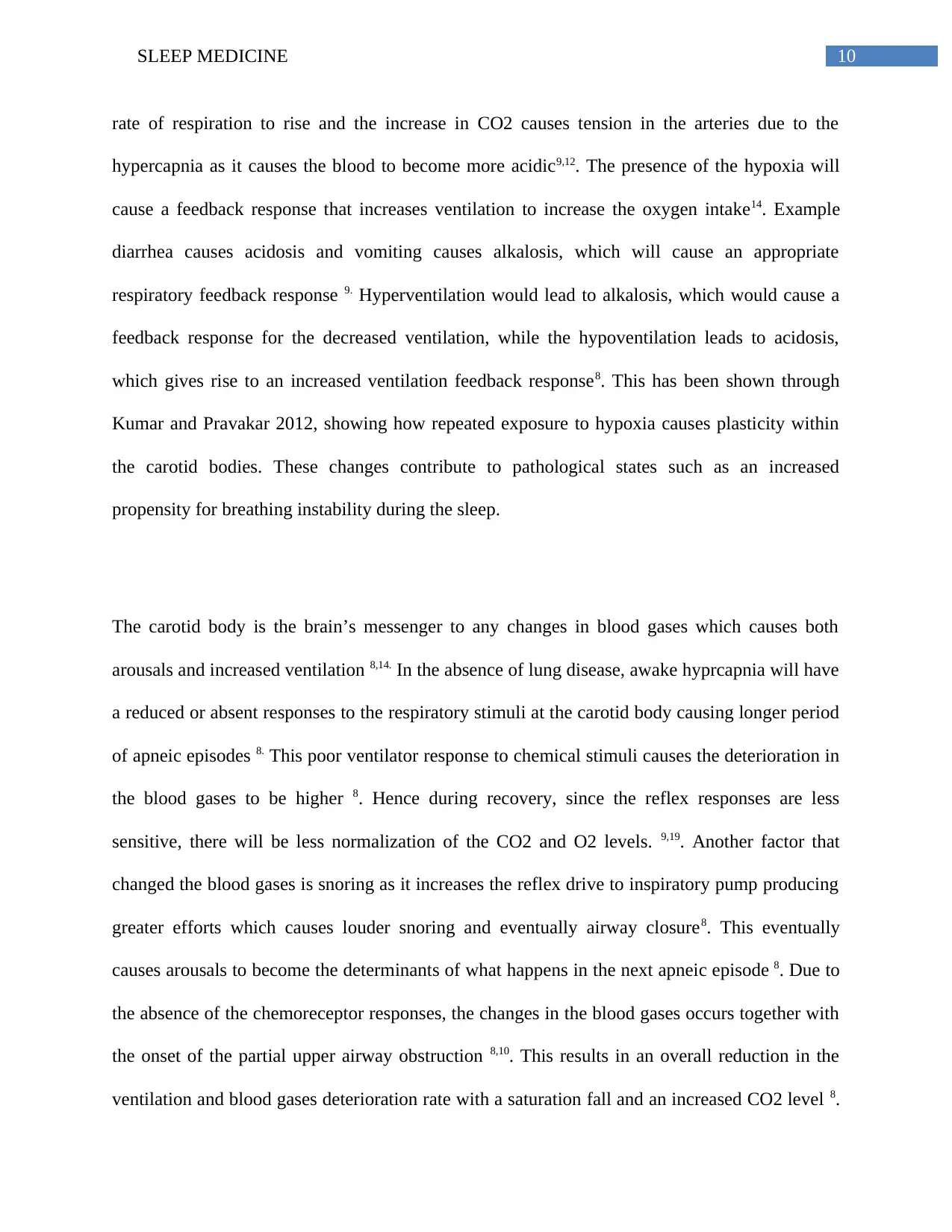
10SLEEP MEDICINE
rate of respiration to rise and the increase in CO2 causes tension in the arteries due to the
hypercapnia as it causes the blood to become more acidic9,12. The presence of the hypoxia will
cause a feedback response that increases ventilation to increase the oxygen intake14. Example
diarrhea causes acidosis and vomiting causes alkalosis, which will cause an appropriate
respiratory feedback response 9. Hyperventilation would lead to alkalosis, which would cause a
feedback response for the decreased ventilation, while the hypoventilation leads to acidosis,
which gives rise to an increased ventilation feedback response8. This has been shown through
Kumar and Pravakar 2012, showing how repeated exposure to hypoxia causes plasticity within
the carotid bodies. These changes contribute to pathological states such as an increased
propensity for breathing instability during the sleep.
The carotid body is the brain’s messenger to any changes in blood gases which causes both
arousals and increased ventilation 8,14. In the absence of lung disease, awake hyprcapnia will have
a reduced or absent responses to the respiratory stimuli at the carotid body causing longer period
of apneic episodes 8. This poor ventilator response to chemical stimuli causes the deterioration in
the blood gases to be higher 8. Hence during recovery, since the reflex responses are less
sensitive, there will be less normalization of the CO2 and O2 levels. 9,19. Another factor that
changed the blood gases is snoring as it increases the reflex drive to inspiratory pump producing
greater efforts which causes louder snoring and eventually airway closure8. This eventually
causes arousals to become the determinants of what happens in the next apneic episode 8. Due to
the absence of the chemoreceptor responses, the changes in the blood gases occurs together with
the onset of the partial upper airway obstruction 8,10. This results in an overall reduction in the
ventilation and blood gases deterioration rate with a saturation fall and an increased CO2 level 8.
rate of respiration to rise and the increase in CO2 causes tension in the arteries due to the
hypercapnia as it causes the blood to become more acidic9,12. The presence of the hypoxia will
cause a feedback response that increases ventilation to increase the oxygen intake14. Example
diarrhea causes acidosis and vomiting causes alkalosis, which will cause an appropriate
respiratory feedback response 9. Hyperventilation would lead to alkalosis, which would cause a
feedback response for the decreased ventilation, while the hypoventilation leads to acidosis,
which gives rise to an increased ventilation feedback response8. This has been shown through
Kumar and Pravakar 2012, showing how repeated exposure to hypoxia causes plasticity within
the carotid bodies. These changes contribute to pathological states such as an increased
propensity for breathing instability during the sleep.
The carotid body is the brain’s messenger to any changes in blood gases which causes both
arousals and increased ventilation 8,14. In the absence of lung disease, awake hyprcapnia will have
a reduced or absent responses to the respiratory stimuli at the carotid body causing longer period
of apneic episodes 8. This poor ventilator response to chemical stimuli causes the deterioration in
the blood gases to be higher 8. Hence during recovery, since the reflex responses are less
sensitive, there will be less normalization of the CO2 and O2 levels. 9,19. Another factor that
changed the blood gases is snoring as it increases the reflex drive to inspiratory pump producing
greater efforts which causes louder snoring and eventually airway closure8. This eventually
causes arousals to become the determinants of what happens in the next apneic episode 8. Due to
the absence of the chemoreceptor responses, the changes in the blood gases occurs together with
the onset of the partial upper airway obstruction 8,10. This results in an overall reduction in the
ventilation and blood gases deterioration rate with a saturation fall and an increased CO2 level 8.
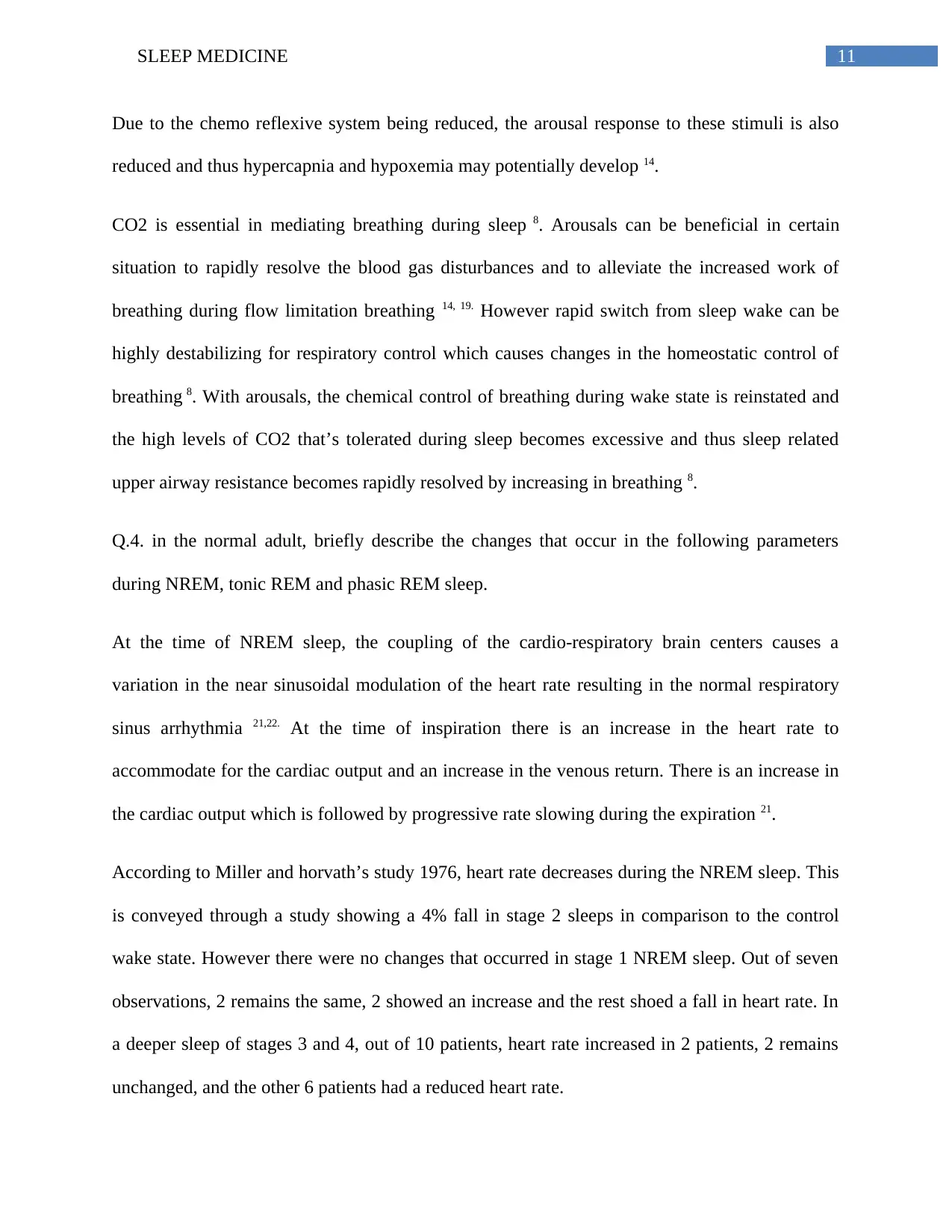
11SLEEP MEDICINE
Due to the chemo reflexive system being reduced, the arousal response to these stimuli is also
reduced and thus hypercapnia and hypoxemia may potentially develop 14.
CO2 is essential in mediating breathing during sleep 8. Arousals can be beneficial in certain
situation to rapidly resolve the blood gas disturbances and to alleviate the increased work of
breathing during flow limitation breathing 14, 19. However rapid switch from sleep wake can be
highly destabilizing for respiratory control which causes changes in the homeostatic control of
breathing 8. With arousals, the chemical control of breathing during wake state is reinstated and
the high levels of CO2 that’s tolerated during sleep becomes excessive and thus sleep related
upper airway resistance becomes rapidly resolved by increasing in breathing 8.
Q.4. in the normal adult, briefly describe the changes that occur in the following parameters
during NREM, tonic REM and phasic REM sleep.
At the time of NREM sleep, the coupling of the cardio-respiratory brain centers causes a
variation in the near sinusoidal modulation of the heart rate resulting in the normal respiratory
sinus arrhythmia 21,22. At the time of inspiration there is an increase in the heart rate to
accommodate for the cardiac output and an increase in the venous return. There is an increase in
the cardiac output which is followed by progressive rate slowing during the expiration 21.
According to Miller and horvath’s study 1976, heart rate decreases during the NREM sleep. This
is conveyed through a study showing a 4% fall in stage 2 sleeps in comparison to the control
wake state. However there were no changes that occurred in stage 1 NREM sleep. Out of seven
observations, 2 remains the same, 2 showed an increase and the rest shoed a fall in heart rate. In
a deeper sleep of stages 3 and 4, out of 10 patients, heart rate increased in 2 patients, 2 remains
unchanged, and the other 6 patients had a reduced heart rate.
Due to the chemo reflexive system being reduced, the arousal response to these stimuli is also
reduced and thus hypercapnia and hypoxemia may potentially develop 14.
CO2 is essential in mediating breathing during sleep 8. Arousals can be beneficial in certain
situation to rapidly resolve the blood gas disturbances and to alleviate the increased work of
breathing during flow limitation breathing 14, 19. However rapid switch from sleep wake can be
highly destabilizing for respiratory control which causes changes in the homeostatic control of
breathing 8. With arousals, the chemical control of breathing during wake state is reinstated and
the high levels of CO2 that’s tolerated during sleep becomes excessive and thus sleep related
upper airway resistance becomes rapidly resolved by increasing in breathing 8.
Q.4. in the normal adult, briefly describe the changes that occur in the following parameters
during NREM, tonic REM and phasic REM sleep.
At the time of NREM sleep, the coupling of the cardio-respiratory brain centers causes a
variation in the near sinusoidal modulation of the heart rate resulting in the normal respiratory
sinus arrhythmia 21,22. At the time of inspiration there is an increase in the heart rate to
accommodate for the cardiac output and an increase in the venous return. There is an increase in
the cardiac output which is followed by progressive rate slowing during the expiration 21.
According to Miller and horvath’s study 1976, heart rate decreases during the NREM sleep. This
is conveyed through a study showing a 4% fall in stage 2 sleeps in comparison to the control
wake state. However there were no changes that occurred in stage 1 NREM sleep. Out of seven
observations, 2 remains the same, 2 showed an increase and the rest shoed a fall in heart rate. In
a deeper sleep of stages 3 and 4, out of 10 patients, heart rate increased in 2 patients, 2 remains
unchanged, and the other 6 patients had a reduced heart rate.
⊘ This is a preview!⊘
Do you want full access?
Subscribe today to unlock all pages.

Trusted by 1+ million students worldwide
1 out of 22
Your All-in-One AI-Powered Toolkit for Academic Success.
+13062052269
info@desklib.com
Available 24*7 on WhatsApp / Email
![[object Object]](/_next/static/media/star-bottom.7253800d.svg)
Unlock your academic potential
Copyright © 2020–2025 A2Z Services. All Rights Reserved. Developed and managed by ZUCOL.


